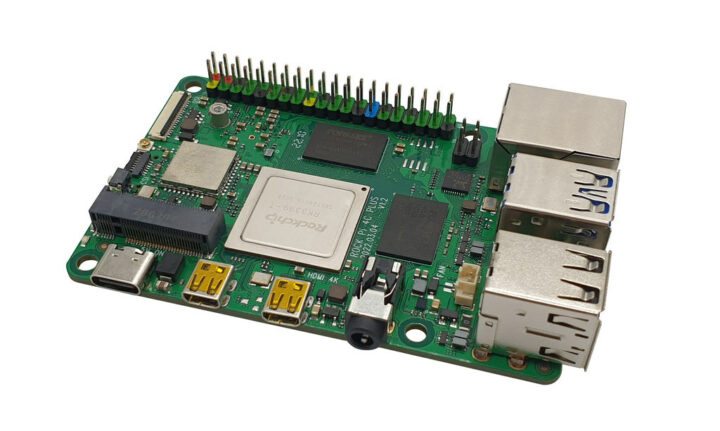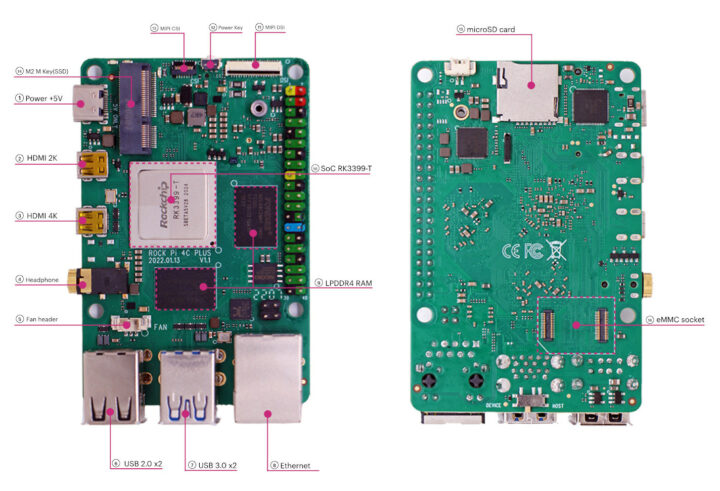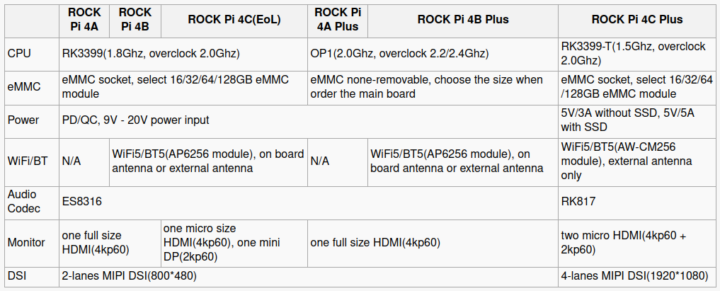ROCK Pi 4 Model C+ is a single board computer (SBC) by a Rockchip RK3399-T hexa-core processor @ 1.5 GHz, equipped with 4GB RAM, and two micro HDMI ports to drive up to one 4K display, and one 2K display.
It is yet another ROCK Pi 4 SBC from Radxa, and the first to use the down-clocked RK3399-T processor with other models based on Rockchip OP1 processor clocked at 2.0GHz (overclockable to 2.2/2.4GHz) or the traditional Rockchip RK3399 @ 1.8 GHz (overclockable to 2.0 GHz), and also the first of the family to offer dual HDMI output.
 ROCK Pi 4 Model C+ specifications:
ROCK Pi 4 Model C+ specifications:
- SoC – Rockchip RK3399-T big.LITTLE hexa-core processor with
- 2x Arm Cortex-A72 @ up to 1.5 GHz (up to 2.0 GHz overclock)
- 4x Cortex-A53 @ up to 1.4 GHz (up to 1.6 GHz overclock). Note the processor datasheet says the Cortex-A53 cores are limited to 1.0 GHz, but Radxa confirmed the 1.4/1.6GHz numbers.
- Mali-T864 GPU with support OpenGL ES1.1/2.0/3.0/3.1, OpenVG1.1, OpenCL, DX11, and AFBC
- VPU with 4K VP9 and 4K 10-bit H265/H264 decoding, 1080p60 H.264 hardware encoding
- System Memory – 4GB LPDDR4
- Storage
- MicroSD card slot
- eMMC socket up to 128GB
- Support for M.2 Key M 2230 NVMe SSD up to 2TB (PCIe 2.0 x4) – Note the photo below should the wrong M.2 connector
- Optional 4MB SPI flash with support for NVMe or Network boot (Note: it will reduce available DSI lanes by 2)
- Video Output / Display Interface
- Micro HDMI 2.0 port up to 4K @ 60 Hz
- Micro HDMI 2.0 port up to 2K @ 60 Hz
- 4-lane MIPI DSI via FPC connector (only 2 lanes if the SPI flash is soldered to the board)
- Dual independent display support (not three before the 2K HDMI and MIPI DSI interfaces are multiplexed)
- Audio – 3.5mm stereo audio+mic jack, digital audio via HDMI; RK817 HD codec supporting up to 24-bit/96Khz audio
- Camera – 2-lane MIPI-CSI2 connector for cameras up to 8MP
- Connectivity
- Gigabit Ethernet RJ45 port with PoE via additional HAT
- Dual-band 802.11ac WiFi 5, Bluetooth 5.0 (AzureWave AW-CM256 module) with u.FL antenna connector
- USB – 2x USB 3.0 host ports including on OTG (at the top), 2x USB 2.0 host ports
- Expansion – 40-pin expansion header with 1x UART, 2x SPI bus, 2x I2C bus, 1x PCM/I2S, 1x SPDIF, 1x PWM, 1x ADC, 6x GPIO, and power signals (5V, 3.3V, and GND)
- Misc – Power button, PWM fan header
- Power Supply – 5V/3A via USB-C port (5V/5A recommended if an SSD is connected)
- Dimensions – 85 x 54 mm
 Radxa provides support for Debian/Ubuntu Linux, Android 7.1/9.0/11 for the board, with open-source GPU drivers (that should be Panfrost), as well as hardware access/control library for Linux/Android. All RK3399/OP1 processors are software compatible, so you’d be able to follow the same Wiki as for other ROCK PI 4 boards.
Radxa provides support for Debian/Ubuntu Linux, Android 7.1/9.0/11 for the board, with open-source GPU drivers (that should be Panfrost), as well as hardware access/control library for Linux/Android. All RK3399/OP1 processors are software compatible, so you’d be able to follow the same Wiki as for other ROCK PI 4 boards.
The Rockchip RK3399-T simply lowers the BoM cost together with some other optimizations.
Besides the Rockchip RK3399-T processor, one other major difference is that the new ROCK Pi 4 Model C+ SBC does not support USB PD anymore, and you’d need to power it up with a 5V USB-C power adapter. Radxa managed to free up 2-lane for MIPI DSI, which should also enable the extra 2K micro HDMI port unless you also solder an SPI flash. The audio codec and wireless modules are also been changed with the ESS ES8316 chip and AP6256 modules giving place to Rockchip RK817 audio codec and AzureWave AW-CM256 module without changing the key specifications.
ROCK Pi 4 Model C+ is currently sold on Allnetchina for $59.99 plus shipping, as well as on Ameridroid for $64.95 (Note the photos are correct, but the specs on Ameridroid are wrong at the time of writing).
Thanks to j_c for the tip.

Jean-Luc started CNX Software in 2010 as a part-time endeavor, before quitting his job as a software engineering manager, and starting to write daily news, and reviews full time later in 2011.
Support CNX Software! Donate via cryptocurrencies, become a Patron on Patreon, or purchase goods on Amazon or Aliexpress






instead of investing in software support (aka upstream linux) they release more hardware – and you wander why RPIs are selling that well…
Rpi success is unrelated with investment into SW support. They don’t need to invest anything since they have large enough community to do everything for them. For free. Also their HW is not changing much so software support is anyway dirt cheap.
What should be asked is why do you have to keep rewriting software for fixed standards. You don’t have to rewrite software every time you change a light bulb unless you extended features.
Lol. Nope. They (RPi) have quite good OS and software support for their boards, if you compare it with others SBC manufacturers. Others that have good SW support apart from RPi: hardkernel AFAIK. Never tried Rock/NanoPi.
If you’re SBC manufacturers, want your products success, but wish that the community provide everything (OS, SW, etc) for free; you’re either a moron, idiot, or brain-dead.
You need to have a monopoly / luck / position of Rpi or invests somewhere between 10 and 100x more as they did (majority in sales) just to be relevant. Do you think capitalist logic and economy doesn’t apply here? There are other things then software support. Where million per year means little. Now, how many SBC makers can afford to compete and throw a bag of cash “to succeed” where business logic is to exploit community to make SW support for you. Rpi doesn’t need to invest a cent into software support. “You” are making it for them for free. They just pack it and sell it to you back … Perhaps today they trow something back to community …
@Jonh: maybe read @JohnY argument first. I’ve responding his comment. Software is on the important side of equation too. Could you imagine, if RPi launch with abysmal OS and SW? It’ll DoA. They have at least a minimum OS and SW requirement to survive. If not, they’re history now.
And yes, the monopoly/luck/positioning too have an important aspect in RPi success. But without OS and SW, it’s just junk.
FYI. This product is selling for about a decade now. Making smart one line conclusions out of that is just joke. Or not even that.
Pretty amateur perspective. To reach dumb users, generate profits and have no expenses with SW support whatsoever, this is certainly must have. Probably everyone would agree. Ofc there is certain percent of serious pro usage, which are happy they don’t need to start from a very low end.
But many people that reads this site would not agree. We make that SW. Some for fun, others for cash. Rpi is not fun for true experts, because its trivial, designed cheap / terrible and is not open source friendly (its corporate controlled) … average Joe doesn’t understand nor care about that, true. But he is also not in a position to understand is it hardware or is it software that is playing tricks with him … he has time to waste and Rpi is nice for that.
Lol. Lack of reading comprehension? What’re you talking about? But if it makes you happy, then yes, yes, you’re right. :p
But still new and new SBC boards come. So all those 3 things described above is related to users too?
@Peter: pardon, what’s the 3 things?
Hahahaha upstream kernel??? Rpi doesnt support their boards on upstream kernel. They use a forked kernel for all their hacks.
Does ubuntu or manjaro use upstream kernel with rpi4? NO!
This board would only change the dtb. That’s all. For everything else, RK3399 has excellent support on real upstream kernel, not like your potatos.
Also, radxa invest a LOT on kernel maintenance, that doesnt have anything in common with new hw. The soc is mostly the same. It’s a cheaper alternative for the original rockpi4 bc of the shortage, bc right now rpi4 are far more expensive than radxa boards.
> radxa invest a LOT on kernel maintenance
Care to elaborate what you’re talking about?
sources?
Considering the amount of resources that rpi has, their software support its ridiculously bad as a linux platform. Full of hacks that eventually were sorted and lack of decent vpu on aarch64 inside and outside the browser. V4l2 does work on certain conditions inside x11/wayland. with several hundred times more resources than the competitors and after all this years, rpi4 is an expensive unsupported piece of shit.
If you compare it with x86, then yes, RPi’s full of hacks. Have a mainline kernel, but with many minuses (some devices may not be initialized properly, etc..). But if you compare it with another arm-based SBC (sans more matured RK3399-based, or the ancient amlogic? SBC), it’s quite good. Almost all SBC is full of hacks, AFAIK.
And they paid a developer for developing their vulkan driver for RPi4 GPU. Quite good move.
Oh, and they’re for-profit organization now. So, you know.. money first. And how can they collect more money with minimal effort/spent.
Yes, right now it’s expensive, but it’s supported. They have OS images that updates quite regularly, that you can download in their website.
Other example: hardkernel ahaha on manjaro utilizing the N2 with upstream kernel was an impossible mission. The HW basically hanged all the time. Once you install linux-odroid (not upstream) then the board works great. Again, not the way to support hw. I believe manjaro stopped utilizing upstream for odroids and they use their patched pile of shit.
Instead of collaboration among every other vendor, forking a kernel and applying patches there like odroid and rpi does, other vendors do collaborate on upstream kernel. I am not saying that odroid do not pay baylibre (like radxa) for kernel maintenance, but they way of linux is far from being collaborative or open source friendly. Like rpi.
Yep. Like you’ve said, almost all SBC is full of hacks. So, don’t just hating those ‘little’ guys. You bark to the wrong trees. You should address the critics to ARM holdings. If they have their shits right, it’ll far more easier for RK, Amlogic, Broadcomm, etc. If even after ARM provide full source to RK, Amlogic, etc; but they still cannot provide better SW. Then yes, you can ‘shoot’ them.
> They don’t need to invest anything since they have large enough community to do everything for them
BS. None of these ‘community members’ has access to the primary OS and I would believe they pay more employees dedicated to ThreadX alone than any of the other SBC makers can afford to pay for the whole software spectrum they need to address (kernel, u-boot, UEFI, tools, whatever).
> Also their HW is not changing much so software support is anyway dirt cheap.
Their HW made recently a big change (VideoCore IV prior to 2020, now VideoCore VI). Just think about the efforts to bring stuff like USB and netbooting to RPi 4 (totally incompatible to the way it worked on RPi 3/3+ and requiring poor souls hacking PCIe and USB host controller drivers in ThreadX). I would assume 2D/3D graphics acceleration also changed with this platform switch.
The software support of RPIs is quite appalling though…
They’re punching way below their weight.
Changes in hardware is likely caused by shortage of the components. Can someone confirm?
Sadly, yes.
> Changes in hardware is likely caused by shortage of the components.
Huh? Physically they made a drop-in replacement for RPi 4B and recuded the BOM costs: dumb 5V instead of USB PD, cheaper SoC, no eMMC but just a socket, no antenna and so on. Lower BOM costs -> more competitive retail price.
But the result seems weird. An 2230 M.2 key E slot labeled ‘SSD’? Maybe some Kingspec/Kingdian crap exists that short and with Key E (the only quality SSDs of this length are KIOXIA BG4 and they are Key M). 5V/5A as DC-IN spec? Seriously?!
The M.2 in board in photo above looks different from board in allnetchina store, looks allnetchina photo newer version, I don’t understand M.2 key not sure what type it is. They moved CPU from bottom, why did not put M.2 on bottom for longer SSD ?
Indeed, the Allnetchina store photo shows a key M slot so the KIOXIA BG4 SSDs from 128GB to 1TB fit directly.
> They moved CPU from bottom, why did not put M.2 on bottom for longer SSD ?
Since RockPi 4 C- is designed as a physical drop-in replacement for RPi 4B –> the board has to fit in all enclosures made for RPi 4B –> neither heatsink nor SSD possible on the bottom of the PCB.
In response to 5V/5A spec…
I llike(d) their previous boards Pi 4 or X because I could power them via laptop adapter with output voltage about 16-17V. Higher voltage means lower current so I did not need to care about wires thickness too much so everything run rock stable.
Yes, it is not PD or QC adapter but it works reliably compared to some 12V QC adapters I used before.
Similarly I liked Hardkernel HC2 because this one accepted 12V what is still better than 5V and offeres stable output on USB ports.
Finally why I don’t want 5V powered boards with high current demand? Few years ago I had 3 Hardkernel XU4 boards running without attention and when they started processing things on 100% they caused fire in my room and damage worth more than £2000. It was my fault because I swapped cables for weaker ones when moving them from different place but from that day I prefer to avoid 5V boards demanding high amps. I am not saying it is not possible to build compute node from these Model C+ boards. I learnt my lesson. But no, thank you.
So what caused the fire is the high current that made the cables overheat?
This board has 2 downsides and they are related to shortages… it’s 5v only, like rpi hw, so, the worst hw; and also a cheaper rk3399 variant.
The price is great considering the current market and the mainline support that RK3399 has. Also, the I/O that packs.
A surprise thing to initially see considering they are gearing up to release the RK3588 board.
But then looking at the price, it is likely to be potentially appealing at the lower end of the market and may take of the prospective Odroid M1 purchasers.
The I/O will be appealing (if 2230 SSD’s are readily available).
But the deficiencies of the RK3399 may not be enough, especially with being even weaker than usual and so any appeal might quickly wane when thinking about the bigger picture.
Yep, odroid M1 is a very nice board indeed.
> Support for M.2 Key B 2230 NVMe SSD up to 2TB (PCIe 2.0 x4)
‘Key B’ is in conflict with Radxa’s board picture (showing a key E M.2 slot labeled as ‘M2 M key’) and SSD reality. The few non-crappy 2230 NVMe SSDs (KIOXIA BG4) are all key M. And won’t fit into a key E slot.
Yes, they pay baylibre and others for kernel maintenance for their boards. Like many others, pay for third party devs to do kernel maintenance. It may be too little? Probably, but it’s a lot in relation to the resources THEY have.
Kernel/uboot,etc…
Hold up, T-variant has lower base clock, but otherwise all the same features and maximum clock? What’s not to like, then?
> T-variant has lower base clock
Most probably for a reason called ‘binning’ (selecting dies at factory QA to sell those that work properly at higher clockspeeds and/or lower voltages for more and those that need higher voltages and/or start to become faulty at higher clockspeeds for less).
I guess in this stupid SBC world nobody will do stability/reliability testing with ‘overclocked’ RK3399-T devices like this RockPi 4 C- here.
Shouldn’t this be called the “C-“?
You win.
Hahaha that was a good one
So how does the recent launched Rock 4 SE fit into all this, which is the better board?
Rock 4 SE looks to be the same as ROCK 4B, except for the RK3399-T processor.
Thank you